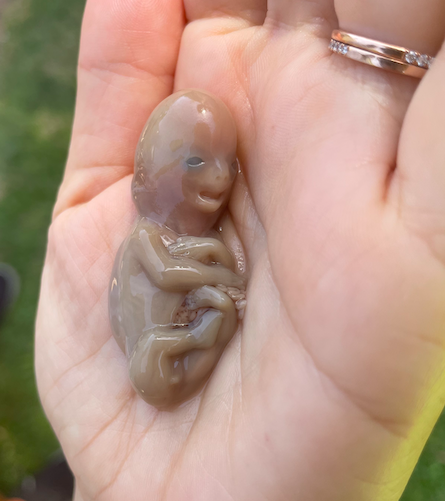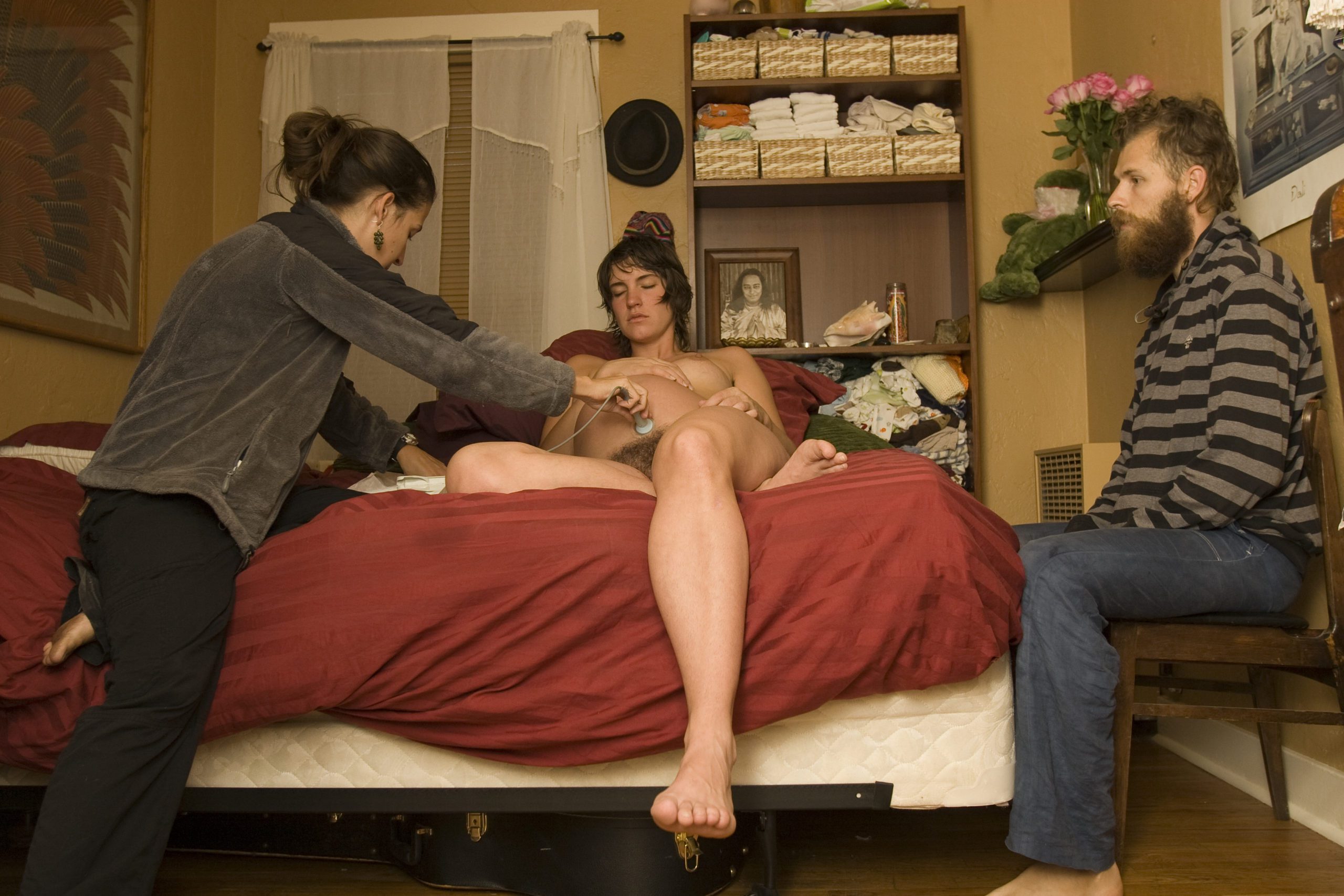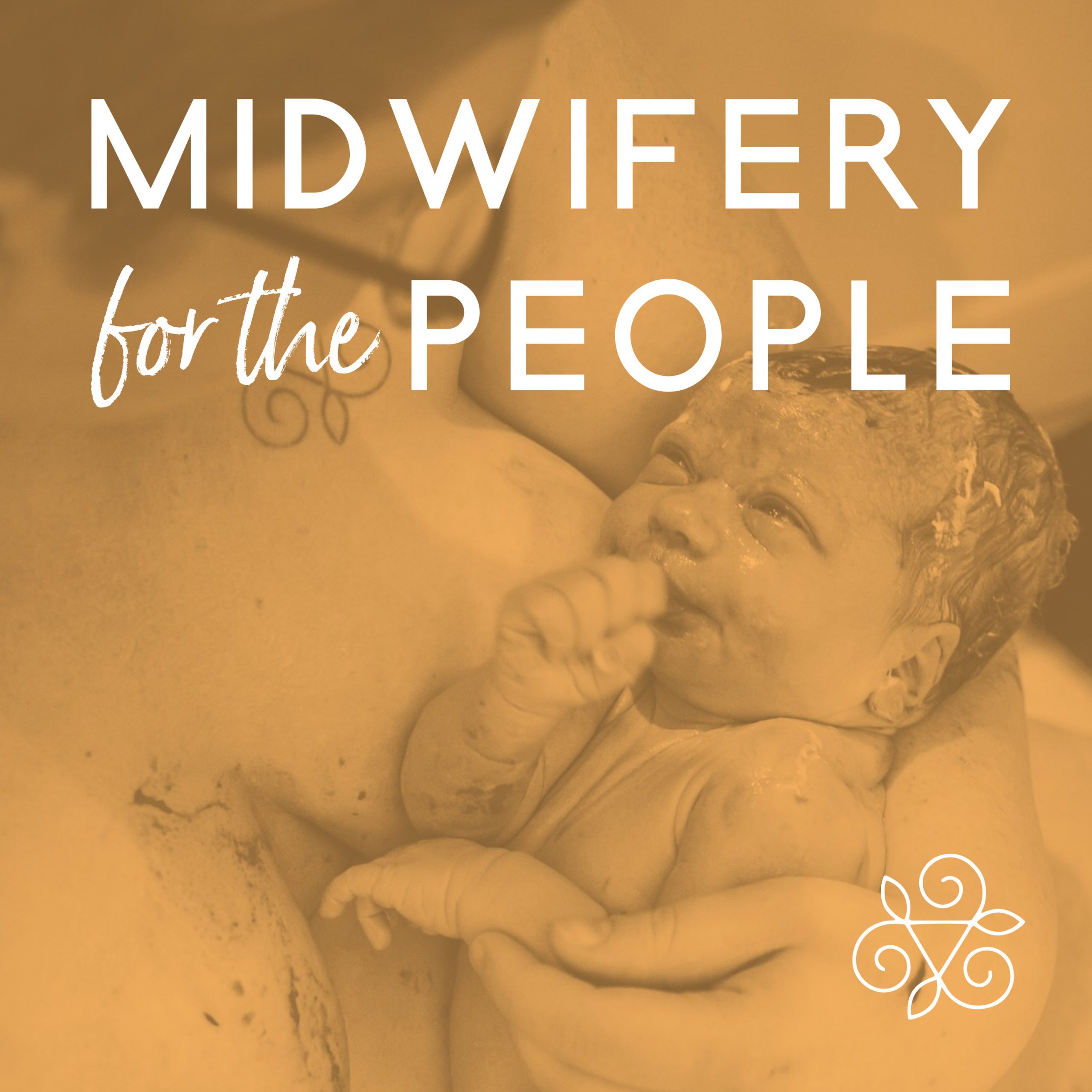***The very very bottom of this post includes photos of miscarried babies at different gestational ages, since understanding what to expect to see is a crucial skill for anyone who wants to support clients experiencing miscarriage.
Miscarriage is a topic that often remains in the shadows, yet it is an integral part of the childbearing journey for many women. My first and second pregnancies both ended in miscarriage, and those experiences radically shaped who I am, my mental health, my spiritual trajectory, and how I experienced my 3rd and 4th pregnancies that ended in live, full term births.
As doulas and midwives, it’s our responsibility to bring the experience of pregnancy loss into the light, providing compassion, love, and understanding when our clients go through this. Miscarriage isn’t just a physical event – it’s a deeply emotional and spiritual experience that deserves to be recognized and honored. In this post, I want to share what I think every doula and midwife needs to know about miscarriage, so you can support your clients through this challenging, sacred, transformative time.
Understanding Miscarriage:
Miscarriage, or early pregnancy loss, occurs in approximately 10-20% of known pregnancies, though the actual number may be higher since many miscarriages happen before a woman knows she’s pregnant. There are different overlapping types of miscarriage, including early pregnancy loss (before 12 weeks), missed miscarriage (where we know the baby has died but hasn’t been birthed yet, which can happen at any gestational age), and second trimester miscarriage. Second trimester miscarriage is any loss where the baby dies between about 12-20 weeks. After 20 weeks is technically a stillbirth which is sort of weird and arbitrary but there are different experiences and risks along the entire continuum of loss.
The physical causes of miscarriage often remain unknown. Some of the known causes include chromosomal abnormalities, hormonal imbalances, structural issues with the uterus, and major health conditions in the mother. For better or worse, unless someone advocates for themselves, most of these possibilities aren’t investigated by the medical world until a woman has had 3 miscarriages, which is then called “recurrent loss”.
It’s important to remember that in pretty much all cases, a miscarriage is not “caused” by anything the mother did or didn’t do – we all know stories of women who did hard drugs, didn’t eat, went to the moon, etc, whose pregnancies continued despite it all. This distinction is crucial since so many women experience feelings of guilt and shame, which are of course not based in reality and can be really painful emotional signatures to carry. And of course this is also the metaphysicial, spiritual reasons a baby might choose not to continue this incarnation. There is so much mystery and so much that is still unknown and will never be knowable.
The emotional and physical impact of miscarriage can be overwhelming and potentially traumatizing, just like full term birth. Miscarriage is decidedly NOT like a heavy period for most women, especially after 6 weeks of pregnancy – that is a total crock of shit.
Physically, a woman may experience a huge variety of things during a miscarriage – bleeding and cramping on and off, water breaking, passing clots, the baby itself, the placenta, and the hormonal experience of labor and birth (bliss, fear, ecstasy). The experience can trigger a wide range of feelings, from sadness and grief to anger and confusion. Many women talk about the early days after miscarriage feeling like a time when they are taking stock of everything in their life, ready to burn anything and everything down if needed. A hugely transformational time. Every woman’s experience is unique, and as birth workers, we must be prepared to meet them in a centered and grounded way wherever they are in their journey.
The Role of Doulas and Midwives in Miscarriage:
Most doulas and midwives do NOT think that comprehensive miscarriage support is part of their role. I think this is an enormous mistake, and I suspect this began when midwifery became more professionalized and silo’d into a rigid Western version of itself. Community standards, rules and regulations, etc. I think it is also likely because of the way that abortion has been handled in the US, which I’m not going to get into here. But many birth workers seem afraid to give miscarriage support because it is “out of scope” (barf) or might get them into dicey territory politically.
In any case, one of the most heinous moments of my midwifery life happened when I was a student and was on a three way call with a midwifery preceptor and a client who was calling to say she was bleeding and cramping in early pregnancy. After a very short bit of info that wasn’t really even accurate – something like, oh it will be like a heavy period, go to the hospital if you fill more than two pads in two hours – the midwife said “give us a call when you’re pregnant again!”. And that was that. I was dumbstruck.
I argue that during a miscarriage, doulas and midwives play a vital role in offering both emotional, spiritual and physical support. It’s not just about what we do, it’s about the energy we bring. The way we approach miscarriage can make all the difference in a woman’s experience and we might be the only people who bring a healthy courageous heart to the table for her.
Women experiencing a beginnings of a miscarriage usually need urgent education and ongoing support around what to expect, what is normal, and feedback about what they are seeing and feeling. Most midwives and hospital providers push for women to use medication to induce miscarriage (it is the same as inducing a labor) or to schedule a surgery to complete the miscarriage (a D and E or D and C). I really believe this is because they don’t understand the normal process of miscarriage and don’t trust that women can handle waiting, and then handle the sort of ambiguous process of normal miscarriage on their own. And I don’t think most women in our culture can, honestly, since most are so out of touch with their own bodies, and are bought into the fear of birth and women’s bodies. But that doens’t mean that it shouldn’t be offered as an option. And that’s where doulas and midwives can come in.
First and foremost, we need to be present emotionally. Holding space for a woman in the midst of a miscarriage means allowing her to express her emotions without judgment or haste. It’s about being a steady, compassionate presence that reassures her that she’s doesn’t have to be alone in her grief if she doesn’t want to be.
In practical terms, this might involve assisting with the physical process of miscarriage in person or viturally (more or less depending on your skills, experiences and role of course), providing basic comfort measures like heat packs, food and hydration, perhaps some herbs. Midwives might be assessing blood loss, taking vitals, helping determine what tissue has passes, providing medications like Cytotec to help the uterus contract more effectively and complete the process (because one it is completed, the bleeding tapers rapidly, and until it is complete, there will me more bleeding), or even recommending that it’s time to move to the hospital if it seems like surgical options should be at the ready, or used imminently because of the extent of blood loss that has already occurred.
At the start of a miscarriage the most important counseling to give is that she will need to be aware of what has already come out of her to be certain that everything IS indeed out at the end. These are the big questions in clinical miscarriage management – how much has she already bled, what has already come out, and what is still left inside. This helps everyone know when the process is actually over, how much longer there might be to go, and whether or not it is safe to continue waiting for the body to complete the process or if other options might be wise.
Continuity of care is another crucial aspect of our role. Miscarriage isn’t a one-time event—it’s an experience that can linger emotionally and physically for months or years. Follow-up visits, whether in person or through a phone call, are essential to check on the woman’s physical recovery and emotional well-being. Most family and friends don’t understand loss at all, and having even one person check in can validate her and make all the difference in those initial months.
So What DO We Expect :
This is larger than I can include here in this resource, since my main goal was to help doulas and midwives understand that they need to offer this kind of support, but I am going to include a few of the most important thigns below, and then link so some other resources for further learning.
The biggest thing we need to talk about is what a miscarriage might be like, which is hard, since there are way more variations of this than there are of full term birth. It can take weeks (or more?) for the body to recognize that a baby has died, and then more days or weeks for the process to ramp up to the point where the baby, the sac and the placenta will be expelled, sometimes together, but often separately. The most common way this looks is the baby, inside of the amniotic sac, will be born first. Earlier babies are smaller of course, and later babies are bigger. Later losses seem to also have the variation that the water may open/break, and the baby may come out completely separately from the sac. It is very common for the placenta to come out a day or days after the baby and the sac. And sometimes part of the sac comes out later as well, usually twisted into a clot – the reason being that the uterus needs something to gather itself around and expel. The sac on it’s own is often not enough mass to pass through without something to help it along.
Usually bleeding crescendos as each of these different stages happens, with the baby and sac being born, or the placenta, or clots of any variety. And once it is out, the bleeding tapers quickly until the next part of the process needs to happen, and then the process repeats. Heavier bleeding, heavier cramping, and then relief and much less bleeding as soon as whichever part it was has passed through the cervix.
The biggest mistakes I have seen be made are when women have the baby come out, and they think it is all over, but there is still the placenta, and potential clots or sac. Then when the bleeding ramps up again, they get scared and go to the hospital where they either pass the tissue on their own, are given medication, or are talked into surgery when the process simply wasn’t over yet. It is super reasonable to have a D and E or D and C if you have lost too much blood. I think that is a judicious use of technology. But there are risks of these surgeries and I have seen them jumped to way before they were necessary.
I have also seen ER nurses and doctors have absolutely no idea what they were doing or talking about when it came to miscarriage, and most hospitals don’t allow women onto the Labor Floor unless they are over 24 weeks. So if your client needs hospital care, I think it makes a lot of sense to go with her, or stay closely connected by phone at the very least. Story time – I had a client/friend who was actively miscarrying a 14 week baby and had lost more blood than we were ok with at home so we went to the local hospital. At the time I was still a student and I didn’t carry medications that could have helped a lot in this situation, which the hospital never offered her for hte many hours she laid in an ER bed bleeding and waiting. And while we were there I watch an ER nurse dig through the bed pan they had placed under her. There was a very large clot and this nurse said to another nurse “I think this is the placenta”. It was very much NOT a placenta, it was a blood clot. So remember that these are the people who will be caring for your client when she goes in. This client ended up with a D and C, and lost quite a lot more blood in the 5 or so hours before they took her back. Cytotec would have been a really easy, lower risk, and inexpensive thing to try in those hours of waiting but no one offered, and I didn’t know to advocate for it yet at that time.
Photos of miscarriages from different gestational ages are also essential for doulas and midwives to be familiar with. I’m including some at the very very bottom of this page, so here’s your warning.
Here are some more resources:
– Aviva Romm’s Every Woman’s Guide to Safe and Empowered Miscarriage Options
– Molly Dutton Kenny’s Full Spectrum Pregnancy Loss Course
– Kayce Pearson’s Miscarriage Series
Navigating the Complex Emotions:
Miscarriage brings a complex web of emotions, not just for the woman experiencing it, but also for her partner and family. As doulas and midwives, we need to be equipped to hold space for grief, which may manifest in many different forms. Some women may express their emotions openly, while others may internalize their grief, processing it in private. There is no right or wrong way to grieve.
One of the most important things we can do is simply listen. Often, well-meaning people try to minimize the pain and say awful things like “at least it was early” or “at least you’re still young”, or “you can try again soon.” These comments, though intended to comfort, can feel dismissive and invalidate the woman’s experience. Instead, we should acknowledge her loss and let her know that it’s okay to grieve. Phrases like, “I’m so sorry for your loss,” or “This must be really hard for you,” can provide comfort and validation.
It’s also helpful to provide resources for additional support. Many women find solace in connecting with and hearing from others who have experienced miscarriage, whether through support groups, podcasts, counseling, books, or online communities. Here are a few of my favorite resources:
– Bearing the Unbearable by Dr. Joanne Cacciatore
– Reframing Miscarriage as a Birth Process (article)
– Miscarriage as a Rite of Passage (article)
– A Miscarriage Story (article)
– The Sacred Side of Miscarriage (episode)
– The Birth/Death of Sable Sage (article)
– The Things We Don’t Talk About : Early Miscarriage (episode)
– Pregnancy After Loss (article)
– The Deeper Experience of an Early Loss (episode)
– Miscarriage as an Embodied Experience (episode)
As doulas and midwives, we are privileged to walk alongside women through the entire spectrum of the childbearing experience, including miscarriage. This is a sacred responsibility, and one that requires us to be fully present, informed, and compassionate. By educating ourselves about miscarriage, holding space for grief, and caring for ourselves, we can honor the women we serve and support them through their loss with empathy and understanding.
Lastly, here are some photos of sweet miscarried babies at different gestations to help you further your learning.
These are from a loss that happened at almost 9 weeks, but the baby had grown to about 6.5/7 weeks. You can see the tiny sac (baby not visible inside), the placenta wrapped in a clot, and then the placenta laid flat. You can read the full story here.



These next ones are from a loss that happened at almost 11 weeks, and the baby had stopped growing at about 8/8.5 weeks. The first one was right after the sac (with baby inside) came out. Next is a bowl with clots covering the bottom, which came out right before/with the sac and baby. Then there is a closer photo of the sac and baby inside (you can see where the tiny eye was forming). This story can be read here.



The next photos are of a baby that stopped growing at 11 weeks and was birthed at 15.5 weeks. You can read the full story here – it is beautiful.







+ show Comments
- Hide Comments
add a comment